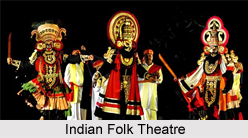 Folk theatre in India has a rich legacy. In the ancient Vedic culture and even in Buddhist literature folk theatre first made its presence felt as an art form to illustrate the unedited realities of life. However, it is only in the medieval period folk theatre gradually became an integral part of Indian drama. Historically folk theatre in India did emerge back in the 15th or 16th century as illustrations from puranas, eposes, historical epics, myths and biographies of the celestial heroes. It is right after the colossal success of Indian traditional theatre as an art form, the distinct style of Indian Natya changed and thus developed a whole new theatre form where Indian myth, dance, history, song, culture, mores, traditions, and beliefs all gained a matchless dimension.
Folk theatre in India has a rich legacy. In the ancient Vedic culture and even in Buddhist literature folk theatre first made its presence felt as an art form to illustrate the unedited realities of life. However, it is only in the medieval period folk theatre gradually became an integral part of Indian drama. Historically folk theatre in India did emerge back in the 15th or 16th century as illustrations from puranas, eposes, historical epics, myths and biographies of the celestial heroes. It is right after the colossal success of Indian traditional theatre as an art form, the distinct style of Indian Natya changed and thus developed a whole new theatre form where Indian myth, dance, history, song, culture, mores, traditions, and beliefs all gained a matchless dimension.
Although much later this particular theatre form was named as the Indian folk theatre, yet it is indeed not an overstatement to say that the very basic rudiments of folk theatre in establishing itself as an artform was there in the mores, heritage and tradition of India. In rural society which is still regarded as the base of folk theatre the activity which displayed the first rudiment of drama are the rituals. Quite ideally therefore rituals, their varied facets and their colossal impact on Indian culture and life formed the very base of the folk theatre in India. Folk theatre therefore boasts the rich history of Indian folk culture that dates back to the age-old antiquity.
Folk theatre in India is mainly narrative in its form. This indeed point towards the origin and the age-old sagas of the sutradhara in Indian natya. The narrator or the sutradhara in order to make his visual art lot more inventive slowly involved acting into his narrative description which in an intimate manner later gave rise to the tradition of narratives in Indian folk theatre. Folk theatre in India still has retained its age old narrative form while echoing a highly dramatic narrative style. There is a long tradition of folk entertainers who either move alone or in groups in rural India. They are the entertainers as well as the preachers of value, philosophical tenets and indeed of religious cult. Folk theatre has adopted their mode of expression amidst dance, music and songs. Thus the spirited, dynamic and ingenious in forms and rich in variety, Indian folk theatre has established itself as the powerful medium of communication in folk cultures. With its timber and colour, dash and élan folk theatre in India is more than entertainment; rather an emotional experience and an effort of creating "an environment of receptivity in which communication of ideas is an effortless process".
Indian folk theatre can actually be divided into two broad categories like the religious and the secular. While the religious folk theatres mainly evolved around the aspects and stories from history, religion and myth; the secular folk theatre actually emerged as a typical form of entertainment. The two forms like the religious and the secular folk theatre therefore started working together whilst influencing each other to create a whole fresh enunciation in Indian natya. To depict the unspoken, to portray the tradition and certainly in featuring the ritualistic aspect of Indian drama symbolism also plays a major role in the stylistic approach of folk theatre in India
Every state in India has its own distinctive forms of folk theatre. Variously known as the Jatra in Orissa, Bengal and Eastern Bihar, Tamasha in Maharashtra, Nautanki in Uttar Pradesh, Rajasthan and Punjab, Bhavai in Gujarat, Yakshagana in Karnataka, Therubuttu in Tamil Nadu Indian folk theatre with its sheer vibrancy since the age-old days has reached out to all. Artistically, folk theatre in India eloquently exemplified the "nine rasas"of the Indian drama. Some of the folk theatres even depicted the true aura of the classical theatres amidst its artistry. Chhau, Lion dance, Kuchipudi, Santhal dance all contributed in weaving that magical sheen of Indian folk theatre which not only stood out as an eminent theatre pattern but also as the plays in depicting the realism of life, love, death, virtues and vice.
The typical concept of stage designing of folk theatre in India once again points towards its simplicity. The actors of the Indian folk theatre generally perform in the make-shift stage. This supports immensely in conversing with the audience in the course of the play as audience participation is an essential part of Indian Folk theatre. The stage for the folk theatres is generally a colossal empty space, which the actors dexterously control and employ to complement with their dialogues and symbolic gestures. Elaborate make ups, masks, chorus, loud music and folk dance are indeed the hallmark of the Indian folk theatre.
With its sheer verve therefore Indian folk theatre is just not a theatre form but is a lot more. It unfurls the saga of the voyage of Indian drama from the eposes to the modish theatre pattern. It is the chronicle of Indian drama where for the very first time theatre broke the barrier of orchestra and pits and reached the mass in a whole new way through the quixotic brilliance of music, song and folklores.




